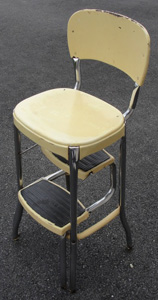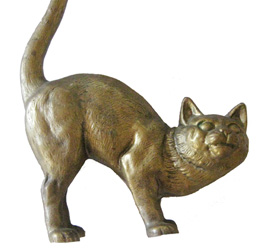 |
|
|||
 |
 |
|||
Copyright © Harry Rinker, LLC 2013 Questions
and Answers QUESTION: I own an Arcade, cast iron, blue corn planter toy. I acquired it as part of a box lot at an auction. What is its value? – J, West Bend, WI ANSWER: Edward H. and Charles Morgan founded the Novelty Iron Works in Freeport, Illinois, in 1868. In 1885, Albert Baumgarten, Edward H. Morgan, and Cyrus Tobias reorganized the company as the Arcade Manufacturing Company. Initially, the company produced coffee mills, a cork extractor, and screen door hinges. Novelty items entered the line. Arcade produced its first animal still banks in 1908. Other still banks followed. In 1921, the cast iron Yellow Cab appeared. The first cast iron farm toy tractor, modeled after a Fordson tractor, followed in 1922. Cast iron toys for girls entered the line in 1923. Arcade quickly became one of the leading manufacturers of cast iron toys. Arcade’s toy buses were a hit at the 1933 Chicago Century of Progress World’s Fair. Arcade turned its attention to war production during World War II. The last toys were made in 1943. Rockwell Manufacturing Company acquired Arcade in 1945, introducing a power tool division a year later. By 1953, when Arcade closed, only its armor plate division remained. See: http://www.stephcohs.org/arcade_structo_toys.htm Arcade’s cast iron corn planter, Model #4220, was introduced in the late 1930s. The toy measures 3 1/2in wide and 5in long. It is marked “Arcade U.S.A.” on the bottom. The tires are black rubber and marked “Arcade Balloon.” Collector interest in cast iron toys is waning, except for high-end examples. Because the toy corn planter crosses over into the farm toy collecting category, its value has not slipped as much as cast iron automobiles and other vehicles. The value of the Arcade #4220 blue cast iron corn planter in very good condition is between $35.00 and $45.00. QUESTION: I have a large lithograph tin pinback button, almost the size of a silver dollar that features Uncle Sam throwing a rope over a tree. When you push down on a lever to the left, an image of Adolph Hitler with his head in a noose emerges from behind a sign that reads: “LET’S PULL / TOGETHER.” What is my pinback worth? – B, Altoona, PA ANSWER: During World War II, there were dozens of anti-Axis (Germany, Italy, and Japan) homefront collectibles. Many feature images of Hitler, Mussolini, and Hideki Tojo, the Japanese prime minister. My toilet paper collection features toilet tissues with the individual images of each. Many of the anti-Nazi (German) objects feature images of Hitler. One of the most popular was a three-dimensional, bent at the waist Hitler with a pin cushion representing his tush. A tag accompanying the piece read: “HE WHO SEEKS TO STICK OTHERS – HIMSELF GETS STUCK IN THE ‘END’.” The image of Hitler’s head on the body of skunk as a decal on the bottom of an ashtray had a tagline” Jam Your Cigarette Butts on This Skunk.” A three-dimensional plaster skunk with Hitler’s head followed the same theme. Two-dimensional paper items outnumbered three-dimensional examples. Postcard images were the most popular. A paper bag featuring a picture of Tojo, Hitler, and Mussolini inside a cast iron kettle that is cooking on a wood fire reads: “SAVE ON HOUSE HEAT AND HELP / MAKE THINGS HOTTER FOR HITLER / FUEL IS NEEDEDTO BUILD WEAPONS.” Evans Novelty Company made your Uncle Sam lithograph pin, which measures 1 5/8” across. There are two variations of the mechanism, one utilizing a lever and the second a double strand of string. Dealer asking prices begin at $50.00 and go as high as $110.00. Hake’s Americana and Collectibles offered an example at $95.00. A rubylane.com dealer sold an example for $175.00. Hopefully, he/she went to the church the following Sunday and thanked whatever god he/she worships for providing such a gullible buyer. The pin is common. I recommend thinking conservatively. In very good and working condition a realistic value is between $40.00 and $60.00.
ANSWER: Your question triggered a wealth of wonderful childhood memories. A Cosco red kitchen step stool occupied the space between the end of the kitchen nook bench and the kitchen cabinet beside the stove in my parents’ home at 51 West Depot Street in Hellertown, PA. The stool plays a central role in one of my favorite stories. My Aunt Ruth, mother’s sister, lived with her family two houses east in the row of six houses in which my parents lived. Aunt Ruth had a gift. No matter what time my mother served dessert, my Aunt Ruth knocked on our front door. How she knew to do this remains a mystery. Our nook jutted out from the kitchen, blocking the view of the front door. My dad and I sat on one side of the nook. My brother and my mother occupied the other side. Although my dad sat by the window, a wall extension blocked his view of our sidewalk and front porch door. When the inevitable knock occurred, my father said, “Come in Ruth.” My mother took offense at his uncanny knack of knowing who knocked. Aunt Ruth would come into the kitchen and immediately sit on the red Cosco step stool. “I see you are having dessert,” she noted. “Would you like some?” my mother inquired. “No, I just finished my supper,” was her sister’s stock answer. After watching us eat dessert for a minute or two, Aunt Ruth would reconsider. “That really looks good. If it is no problem, I would not mind trying some.” My mother, a gentle soul, would set aside her half finished dessert and prepare a plate or dish of dessert as Aunt Ruth swung the red Cosco step stool around to face the end of the nook table. On more than one occasion, my father said to my mother, “why don’t you just prepare a fifth dessert? You know Ruth always decides she wants some after she arrives.” I refrain from describing the harsh look my mother gave my father. The Columbus (Indiana) Specialty Company (COSCO) was founded in 1939. Its initial product was a matchbox that dispensed matches while also providing a space for used matches. In1941, the company patented its first all-metal kitchen stool. Larry Voris, Director of Strategic Projects for Cosco Home and Office Products, a Dorel Company, emailed me a copy of several 1940s advertisements. The “Stylaire” Step Stool came in two models. The Model 4-M DeLuxe step stool featured charcoal, red, and yellow upholstery and retailed for $13.95 to $14.95 (in the far west). The Model 4-C was available in charcoal, tan, and yellow enamel and retailed for $10.95 to $11.75 (in the far west). Today, Cosco Home and Office Products is one of the largest manufacturers of folding furniture, step stools, and ladders. The company continues to manufacture its Retro Counter Chair/Step Stool, Model #11120RED1. The advertisement on its website http://www.coscoproducts.com/eng/ notes: “Whether you need extra seating or to reach that cabinet, this classic combo is all you need. Even grandma would approve of this timeless design that has offered over 70 years of comfort, convenience, and value.” We moved into our home on Depot Street in Hellertown in October 1948. The red Cosco kitchen step stool must have arrived then or shortly thereafter. My collection of merchant stamp redemption catalogs is in storage. Larry Voris confirmed the Cosco kitchen step stool was featured as a redemption product in many of them. Cosco Home and Office Products sells reproduction treads and decals to individuals who wish to restore older models. Emotional and sentimental value, two very important values, often do not translate into monetary value. This is certainly true in this instance. Your Cosco kitchen step stool is garage sale fodder. In reusable condition, its value is between $5.00 and $10.00. Restored, the step stool sells for $35.00 to $45.00. [Author’s Note: If you have a favorite story involving a Cosco kitchen step stool, share it with me at harrylrinker@aol.com.] QUESTION: I have a brass, hunchback cat doorstop that is 10 1/2in tall from the top of its tail to its paw. What is its value? – EN, Altoona, PA, Email Question
ANSWER: The pictures that accompanied your email suggest your doorstop dates from the 1950s or later. It is a copycat (stylistic reproduction) of a cast iron cat doorstop from the 1920s or 1930s. I own one of these early examples. The use of brass or a brass-like material is one indication of its later origin. The poor fit of the two-part cast is the second. The final clue is the evidence of the casting gates. Early examples had these filed smooth. The brass cat doorstop has a secondary resale market value between $20.00 and $30.00, primarily as a conversation piece rather than a cat collectible.Harry L. Rinker welcomes questions from readers about
collectibles, those mass-produced items from the twentieth and twenty-first centuries.
Selected letters will be answered in this column.
Harry cannot provide personal answers.
Photos and other material submitted cannot be
returned.
Send your questions to: Rinker on Collectibles, 5955 Mill
Point Court SE, Kentwood, MI 49512.
You also can e-mail your questions to
harrylrinker@aol.com.
Only e-mails containing a full name and mailing address
will be considered.
You can listen
and participate in
WHATCHA GOT?, Harry’s
antiques and collectibles radio call-in show, on Sunday mornings between 8:00 AM
and 10:00 AM Eastern Time.
If you
cannot find it on a station in your area,
WHATCHA GOT?
streams live on the Internet at www.gcnlive.com.
SELL, KEEP OR TOSS?: HOW TO DOWNSIZE A HOME,
SETTLE AN ESTATE, AND APPRAISE PERSONAL PROPERTY
(House of Collectibles, an imprint of Random House Information Group, $17.99),
Harry’s latest book, is available at your favorite bookstore and via
www.harryrinker.com.
|
||||
 QUESTION: I have a kitchen step stool that I believe dates back to the 1960s. The back, seat, and frame of the steps are yellow. It is marked COSCO. What is its value? – MG, Reading, PA, Email Question
QUESTION: I have a kitchen step stool that I believe dates back to the 1960s. The back, seat, and frame of the steps are yellow. It is marked COSCO. What is its value? – MG, Reading, PA, Email Question